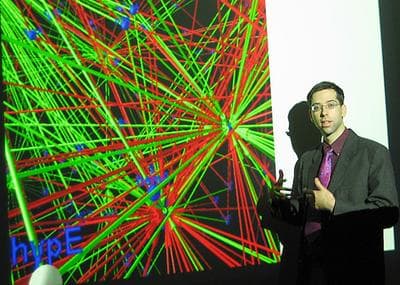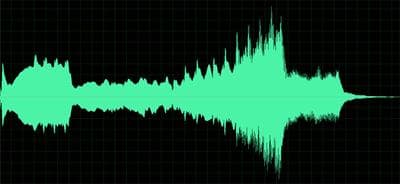Advertisement
Tech Turns Hospitals Into Concert Halls, Diseases Into Songs
Resume
Could music improve the practice of medicine?
In the operating room of just a few decades ago, technology wasn't sophisticated enough to keep track of more than a few basic body functions — mainly blood pressure, breathing and heart rate.
Today, the situation is totally different.
Listen: Surgical Symphonies
http://audio.wbur.org/storage/2010/03/news_0304_surgical-symphony-happy.mp3
An Unhealthy Cell...
http://audio.wbur.org/storage/2010/03/news_0304_surgical-symphony-sad.mp3
...And The DJ Remix
http://audio.wbur.org/storage/2010/03/news_0304_surgical-symphony-remix.mp3Modern-day hospitals are filled with the beeping, buzzing and chirping of dozens of high-tech machines, which can be noisy and distracting. But a new sound technology by local researchers has the potential to turn operating rooms into concert halls and diseases into songs.
Heart monitors. Ventilators. Respirators. Defibrillators. Alarms. A 21st-century operating room can be chaos for the eyes and ears. And when too many machines compete to be seen and heard, doctors may miss something important. Or tune them out. Or, worse, turn them off.
In fact, a heart monitor that was off when it was supposed to be on is blamed for the recent death of a patient at Massachusetts General Hospital. Hospital officials say they aren't sure why the monitor had been disabled. But in similar cases around the country, alarms were unplugged because doctors said they were too loud or annoying.
The Operating Room As Concert Hall
So imagine a better way. What if, instead of an operating room cluttered with electronic beeps and tones, it were just filled with music?
If the patient's body functions were normal, the music would play along beautifully. But if the patient had a problem — perhaps a drop in heart rate or trouble breathing — the music would change by becoming dissonant and off-key.
That's the technology that Gil Alterovitz, a researcher at Harvard and MIT, is working to create.

"We felt that music, in some sense, can serve as a translator," Alterovitz says, who is also affiliated with Children's Hospital Boston. "There's more and more information presented, so either we need a new super brain or we need a way to present it to the brain that we have in a way that it can handle it."
His way is music, and his solution is to turn all those beeps and alarms into musical instruments.
"So you can turn your heart rate monitor into the violins, you can turn the blood pressure monitor into violas, and so forth," explains Marco Ramoni, an associate professor at Harvard Medical School who does research with Alterovitz.
"The number of monitors in an operating room increases every year," Ramoni adds, "so at some point the number of monitors we will have will create a terrible cacophony of signals."
But if those signals become musical notes, a doctor would immediately know that harsh-sounding notes mean a patient may be in distress.
Using Music To Track Disease
Music could also be used to track disease.
Take cancer, for example. Scientists use advanced technology to collect an enormous amount of data on something as tiny as an individual cell. Conceivably, they could then follow the health of a cell by translating its genes into musical notes.
"You can turn your heart rate monitor into the violins; you can turn the blood pressure monitor into violas."
Researcher Marco Ramoni
Dissonant notes might mean a tumor is getting worse, in which case a doctor might prescribe chemotherapy. Then, if the music is harmonious again after several rounds of treatment, that would be an indication that the chemo has been successful.
Alterovitz says this technology could also have other applications.
The U.S. Naval Research Laboratory, for example, has inquired whether sonar signals from its submarines, which aren't audible to the human ear, could be turned into music, Alterovitz says. Or, he says, the hundreds of flights monitored by air traffic controllers could become music, too, and a bad note could mean that a plane is off-course.
But this technology doesn't always have to be serious.
Alterovitz used disc jockey mixing software to make a remix of hospital sounds turned into dance music. If you listen closely, you can pick out someone's heart thumping and someone else's respirator whooshing.
Because sometimes scientists just want to have fun.
This story originally aired on March 4. It re-aired Dec. 29.
